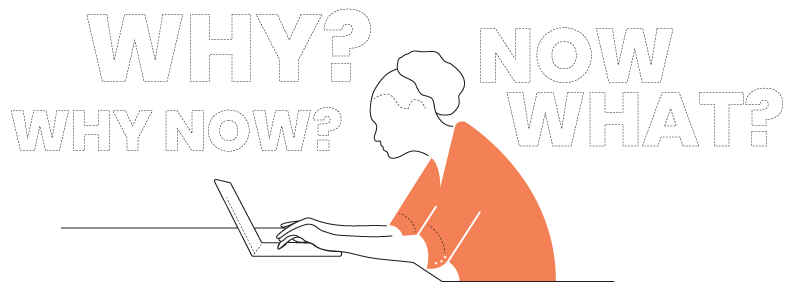You know that prospecting is an important part of the sales cycle. And you also know that there are easier ways into today’s digitally driven world to make an initial connection with a prospect or generate new leads than by cold calling.
One opportunity is sending a prospecting email.
Before you dismiss cold emails as ineffective, consider the following insightful statistics:
- 80% of people prefer sales reps to contact them via email
- 42% of emails are replied to within the first hour
- Following up with a prospect multiple times can double your cold email response rate
Of course, there are over 300 billion emails sent per day. Not only that, but many of them come from a place of wanting to sell.
Take a look at your own inbox and review how many emails are from friends and family versus a business vying for your attention!
Consider that only 24% of sales emails are even opened with the rest being deleted or simply ignored.
So, while email marketing is proven to work, the challenge with email prospecting really comes down to finding ways to stand out in a prospect’s inbox.
Below we talk about not only how to do exactly that, but we also offer 8 prospecting email examples for you to utilize as you’re getting started.
3 questions to ask when writing a prospecting email

Writing relevant and engaging prospect emails isn’t as difficult as it sounds. We’ll get to the technical elements shortly. But before you even begin writing your prospect email, you’ll need to establish the following:
1. Your Why
Do you have a good or compelling reason you’re reaching out to this particular prospect? Whether they are a perfect match for your ideal buyer persona or they’re similar to past clients who have spent a recognizable amount on your products or services, you need to be able to establish value for him/her right away.
2. Why Now?
Once you establish a cold prospect as a perfect fit, it’s important they’re met with a sense of urgency. If there is nothing in your message regarding why your product or service is the right fit in the immediate future, your prospect has no reason to buy immediately. Tap into a specific pain point or internal initiative (bi-annual sale!) to make the biggest impact.
3. Now What?
A clear and concise CTA is needed to drive action on the part of your prospect. This doesn’t necessarily mean they have to spend money. A CTA can encourage them to read a blog or download a case study or even follow you on social media. But “just checking in” emails with no real purpose or value will always fall flat with your prospect.
The written elements of a prospecting email
In order to craft effective prospecting emails, you should be sure to always include the following written elements.
Subject Line
A short phrase that will entice your readers to open your email. Try not to go over 40 characters. You can also use a free subject line tester to try out different variations and see what receives the best score. Always be sure how to measure how it performs with your audience, too, so you can make adjustments as needed.
Preview Text
When you’re scrolling through emails, you’ll notice there is a subject line as well as less bold copy that follows it. The less bold copy is called preview text and acts like a subhead for your emails. Use it to give more information about what your reader can expect to find when they open your email. Most inboxes allow up to 140 characters (including spaces) as a preview line; however, preview text gets cut off after about 40-90 characters.
Body copy
Once your reader opens a prospecting email, the work really begins. Go back to your “why” and your “why now” to write this section and lean in to informing, educating, or pitching your offering.
Call to Action
Return to your “why now” and “now what” to craft the perfect call to action or CTA. This is ultimately what you’re wanting the reader of your prospect email to do. Download a case study, schedule an appointment, try a free demo, sign up to receive their free sample—the possibilities are endless. Ensure that your CTA offers plenty of value to your reader to give it the best odds.
Undoubtedly the most effective prospecting emails will always include these four elements. The more you practice writing these types of emails and testing and analyzing different elements—subject line with an emoji versus subject line without an emoji for example—the better you’ll become at making the connection.
8 prospecting email templates
Sure, you can now pull together an admirable prospecting email on your own. But in case you’d like a little help, we’ve created 8 prospecting email examples to get you started. Use them individually for your prospecting efforts or tie them together as a series.
According to the statistics, cold email campaigns with 4 to 7 emails per sequence get three times as many responses compared to campaigns with less than 4 emails per sequence!
1. The soft intro

Hi <first name>,
As a <job title> you already know that <pain point> is a struggle.
And it’s true, there’s no magic elixir that’ll take care of it for you.
But that doesn’t mean there isn’t a solution.
This past year I’ve helped <job titles> just like you <business driver> which resulted in <result>.
Take <client name> for example. S/he had a hard time with <pain point> too. Until she took the leap and partnered with <your business name>.
You can find his/her full story here <link to blog/downloadable case study>.
Do you have questions or want to talk more? Hit “reply” and let me know a day and time that work for your schedule.
Talk Soon,
<rep signature>

2. Value follow up

Hello <first name>,
Did you miss my <social media request/initial email>?
I noticed you’re having a hard time with <a pain point>.
At <my company> we <describe what you do in 1 or 2 sentences>.
Wouldn’t it be great if you <how they’d feel after using your product/service—free of burdens, had more time, etc.>?
You can! Here’s proof <link to case studies, testimonials, etc.>.
I’d love to learn more about you and your specific needs around <share a product or service that may be useful to this lead>.
Hit “reply” and share your thoughts.
Looking forward to hearing from you.
<rep signature>

3. The compliment

Hello <first name>,
I came across your recent <article/post/podcast/blog> about <topic>. Your point about <salient point> really struck me.
I thought you might appreciate this <article/podcast/blog> on a similar topic <link to an article that ties back to your product/service>.
Let me know your thoughts.
<rep signature>

4. Educational Follow Up

Hello <first name>,
Did you know that <share an interesting statistic that relates to your product or service>?
But you don’t need to worry about that with <your company’s name>. That’s because we created <product or service> and it was made to help you <state a pain point your customer has that your product/service solves>.
How so? Check out this <infographic/blog/eBook> to learn more.
Let’s talk about how you can <state a goal you can help your lead reach>, too. Choose a time that works best for you <link to your scheduling tool>.
Talk Soon,
<rep signature>

5. The congratulatory email

Hello <first name>,
Congratulations on your new role at [company name]!
As you’re settling in, I’m sure you’re looking to score some big wins in your first few months. Results like:
<impressive stat you’ve helped a customer reach—link to case study/testimonial/blog if available>
<impressive stat you’ve helped a customer reach—link to case study/testimonial/blog if available>
<impressive stat you’ve helped a customer reach—link to case study/testimonial/blog if available>
The good news is, I think I can help you do the same (or better!) Let’s connect <insert calendar link> and talk about your goals so I can tell you honestly if <product/service> would be a good match.
Looking forward to it,
<rep signature>

6. Value proposition

Hello <first name>,
When it comes to <your industry> I really enjoy <something you do frequently in your line of business>.
And that’s good because you don’t enjoy <what you sell that your lead doesn’t enjoy doing—but you do!>.
Thankfully, <company name> is. Maybe that is why we get asked this question so often: <Insert the #1 question you get asked about your product/service>.
I wish I had a one-size-fits-all answer. But really, <explain why your response varies per customer>.
The good news is that no matter who you are, you can be successful with <insert what you help people/businesses become successful with>. Like <share 1 thing you often tell customers to do>. Or <share 1 thing you often tell customers to do>.
Don’t believe me?
Then don’t miss <TITLE> <link to an interesting asset your business uses to educate leads>.
Are you interested in learning more? I’d love to talk. Hit reply and let’s get something on our calendars.
Talk soon,
<rep signature>

7. Encourage curiosity

Hello <first name>!
Have you heard? <Share an interesting statistic about your industry>.
Pretty fascinating, right?
At <company name> <industry> is all we do. So you could say we know A LOT about it. Be the first to read our latest and greatest <social media posts, blogs, articles, videos> when you follow us on <social media channel> <link>.
Even if you decide not to follow us on social media, I hope to continue to connect in your inbox.
Talk Soon,
<rep signature>

8. The Bold Ask/Pitch

Hi <first name>,
Your latest <post/announcement> regarding [news] reminded me…
Have you seen this article on <related topic>? I thought you’d find it useful as you move forward.
Out of curiosity, are you currently working to improve <something related to their post that also relates to what you do>? I’m happy to share my insights with you.
Hope to hear from you soon.
<rep signature>







